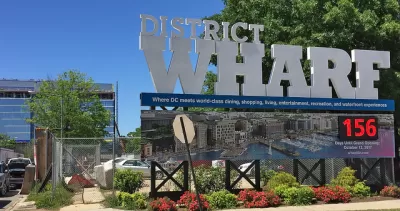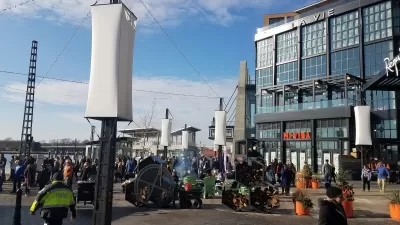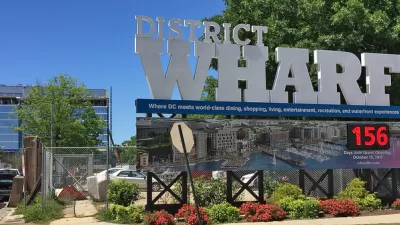Looking back to evaluate the potential of the present.

Jonathan O'Connell presents a history of the Washington, D.C. waterfront—made increasingly relevant as the mega-development known as The Wharf continues to take shape.
Here's how O'Connell describes the The Wharf, after taking a tour of the property with developer Monty Hoffman back in September, just prior to the opening of the project's first phase.
All told, when the second phase is completed in 2022, there will be a mile of waterfront on 24 acres of land, 50 acres of riparian rights in the channel, 1,375 residences, 945,000 square feet of office space, 800 rooms in four hotels, 2,500 parking spaces, and 10 acres of parks and open spaces.
At a cost of $2.5 billion, the Wharf is one of the most aggressive efforts in recent memory by the District, maybe by any city, to reinvent a waterfront. It also happens to be located near the site of a previous, infamous attempt at urban transformation: In the 1950s, the federal and local governments leveled thousands of buildings in Southwest and, according to the D.C. Preservation League, forced a total of 23,000 residents and 1,500 businesses to move. They then built a mass of brutalist-style housing complexes around a retail center, Waterside Mall. Little remained beyond the Maine Avenue fish market and a handful of churches. Southwest, the boyhood stomping ground of Marvin Gaye, eventually became a case study of everything urban renewal got wrong about cities and people.
Much of the article, however, focuses on the history of waterfront development in Washington, D.C. and the precedent set by the Inner Harbor in Baltimore. The big question O'Connell means to provide context for is whether The Wharf will finally change the narrative of planning and development failures on the waterfront of the nation's capital.
FULL STORY: Do posh waterfronts make a city world-class? D.C. is betting hundreds of millions on it.

Planetizen Federal Action Tracker
A weekly monitor of how Trump’s orders and actions are impacting planners and planning in America.

Maui's Vacation Rental Debate Turns Ugly
Verbal attacks, misinformation campaigns and fistfights plague a high-stakes debate to convert thousands of vacation rentals into long-term housing.

San Francisco Suspends Traffic Calming Amidst Record Deaths
Citing “a challenging fiscal landscape,” the city will cease the program on the heels of 42 traffic deaths, including 24 pedestrians.

Amtrak Rolls Out New Orleans to Alabama “Mardi Gras” Train
The new service will operate morning and evening departures between Mobile and New Orleans.

The Subversive Car-Free Guide to Trump's Great American Road Trip
Car-free ways to access Chicagoland’s best tourist attractions.

San Antonio and Austin are Fusing Into one Massive Megaregion
The region spanning the two central Texas cities is growing fast, posing challenges for local infrastructure and water supplies.
Urban Design for Planners 1: Software Tools
This six-course series explores essential urban design concepts using open source software and equips planners with the tools they need to participate fully in the urban design process.
Planning for Universal Design
Learn the tools for implementing Universal Design in planning regulations.
Heyer Gruel & Associates PA
JM Goldson LLC
Custer County Colorado
City of Camden Redevelopment Agency
City of Astoria
Transportation Research & Education Center (TREC) at Portland State University
Jefferson Parish Government
Camden Redevelopment Agency
City of Claremont




























